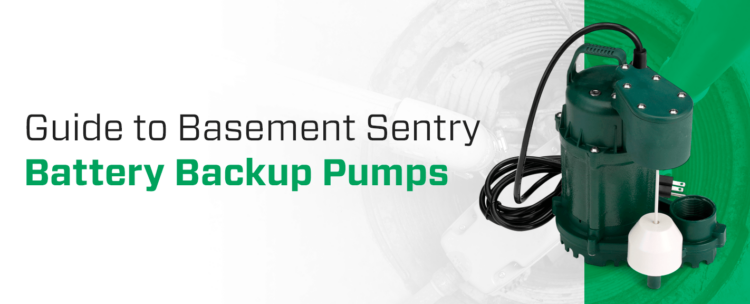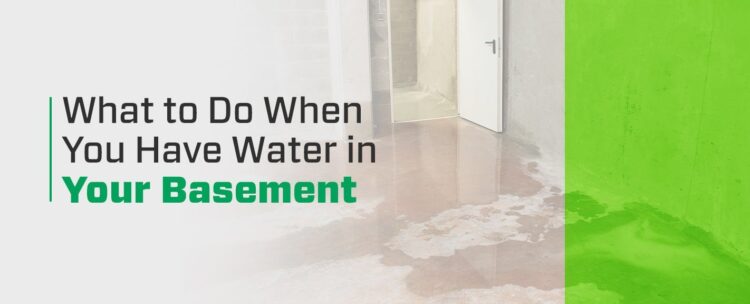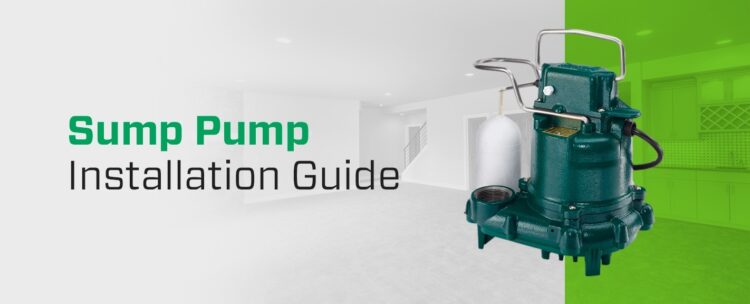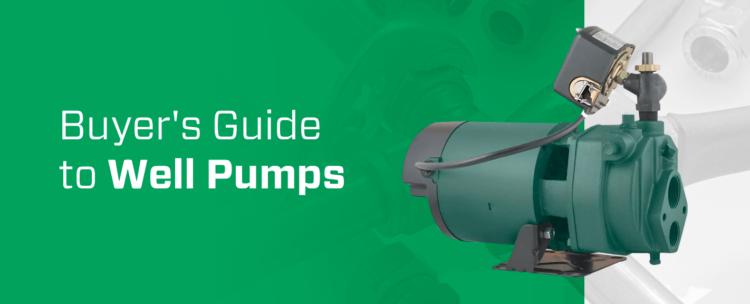Sump pumps and backup sump pumps protect homes with basements from potential water damage. Basements can collect water from rainfall, but sump pumps collect and move this water before it accumulates. Since primary sump pumps operate on electricity, backup sump pumps can take over during a power outage to ensure your basement stays dry even if your main sump pump loses power.
There are two types of backup sump pumps. Battery-powered sump pumps operate on batteries, while water-powered backup pumps operate on local water supplies. Both options can effectively protect your basement from water, but it’s best to consider the features of each type of pump before deciding which one is right for your home.
Why Is it Important to Have a Sump Pump?
Since basements are below ground level, they are prone to water intake and flooding. Moisture can damage your home, so having a sump pump is important for the following reasons:
It Protects Your Furniture and Belongings
Many homeowners use their basements as extra storage space, cozy lounging areas or fun spaces to entertain guests. If you have any appliances, furniture or valuables in your basement, a sump pump can protect those belongings if your basement starts to take in water. It also protects your walls and floors if you have a finished basement.
It Protects Your Home From Mold
Homeowners with unfinished basements should also protect their homes from water damage. Even if you keep all of your furniture and valuables out of your basement, a sump pump can protect your home from mold growth. Mold releases spores into the air that can cause health problems if inhaled, so it’s essential to prevent moisture in your basement to eliminate mold growth conditions.
It Can Help You Save Money
Flood insurance can cover some appliances and home repairs following a flood, but it does not cover everything, such as personal belongings, dehumidifiers, basement improvements and generators. If you have an updated basement with drywall, finished floors, bathroom fixtures and built-in improvements, a sump pump can prevent you from paying for home repairs and replacements.
What Causes Basement Flooding?
While rainfall can cause your basement to collect water, there are also other causes of basement flooding, which include the following:
- Clogged gutters
- Failed drainage tiles
- Improperly installed downspouts
- Poor basement sealing
- Leaking water heater
- Cracked or burst water supply line
- Upward sloping land surrounding your home
What Is the Purpose of a Backup Sump Pump?
A sump pump protects your basement from water damage by removing water during inclement weather or flooding. A backup sump pump protects your basement if your primary pump stops moving water due to a mechanical error, improper installation or power outage.
A backup pump operates using water or battery power, eliminating the need for electricity. During a power outage, a backup pump will use battery power or water pressure to activate and move water while the primary pump is without power. Primary pumps may also stop moving water if they operate beyond their capacities and collect more water than they can move. In this situation, a backup pump can relocate the excess water the primary pump couldn’t handle.
Backup pumps are also useful when a primary pump’s float switch becomes lodged in the pump. The float switch turns the pump on when water enters the basement, but the pump will not operate when the float is stuck against the pump, power cord or discharge pipe. If this occurs, a backup pump can substitute for the primary pump and move water from a basement.
Both battery-powered and water-powered backup pumps can protect homes from water damage when a primary sump pump loses its power source or has a mechanical glitch. However, the type of sump pump that’s right for your home will depend on the following factors:
- Run time
- Pumping rate
- Life span
- Run Time
- Cost
A sump pump’s pumping rate refers to how fast it pumps water from your basement, and its run time refers to how long it can continuously operate. The best sump pump horsepower level for your home depends on how much water you need to move and how far you need to move it. It’s also important to consider a sump pump’s cost and life span. A pump’s life span is how many years it will operate before you need to replace it, and the cost refers to how much it costs over its entire life.
What Is a Battery Backup Sump Pump?
A battery backup pump system includes both the sump pump and a battery backup that homeowners sometimes have to purchase separately. The pump’s battery allows it to operate without electricity, so it can take over if the primary sump pump loses power. It automatically activates if the primary pump stops working, so homeowners can rest assured it will operate even if they are unaware of the power outage.
When looking for a battery backup sump pump, consider these factors:
Run Time
A battery backup sump pump’s run time depends on its battery and charger. The larger the battery, the longer the pump can operate. A higher-quality charger increases the battery’s run time so it can run longer before it stops moving water. Run time can decrease as batteries age, but new batteries typically power a backup sump pump for approximately seven to eight hours.
After a few years, the battery will power the pump for fewer hours at a time, and this run time will continue to decrease as the battery ages. The backup pump may operate for two to three hours instead of eight, requiring a replacement battery. Homeowners need to replace their backup pump’s battery after a few years to prevent a power outage from outlasting their backup pump.
Zoeller at Home’s Basement Sentry® backup pump systems have long battery lives and undergo extensive quality testing to ensure they are effective and reliable. Basement Sentry batteries are AGM sealed, meaning they are maintenance-free.
Pumping Rate
Horsepower (HP) determines how fast and how far your backup pump can move water. Most battery backup sump pumps have ¼ or ⅓ HP. With a new and fully-charged battery, they can typically move approximately 800 to 2,000 gallons per hour (GPH). A battery pump’s pumping rate will decrease as it ages, and it may start to move water at a slower rate one or two years after purchase.
Life Span
Similar to its run time, a battery backup pump’s life span also depends on its battery and charger. A high-quality charger can prolong a pump’s battery life span, but most batteries need replacing within three years of purchase.
Cost
Backup sump pump kits typically cost between $200 and $900, making them an excellent investment to protect your home. Pumps with lower pumping power cost less than pumps with higher pumping power. Before purchasing a battery backup pump, consider how much water your basement typically takes in. If you live in an area with low rainfall, you may only need a pump with low pumping power. However, you will need a pump with higher pumping power if you live in an area with heavy rainfall.
Benefits
Battery backup sump pumps are very versatile and work well in most basements. With a new battery and quality charger, a battery backup pump can be very powerful and effective. Battery-powered pumps also have a fairly straightforward installation process because they connect to the same discharge pipe as primary sump pumps. A battery-powered backup sump pump can save your basement if a mechanical glitch or power outage occurs.
What Is a Water-Powered Sump Pump?
A water-powered sump pump operates on water pressure. It uses city water pressure to move water from your basement if your primary sump pump loses power.
If you’re considering a water-powered sump pump, think about these factors:
Run Time
Water-powered backup sump pumps can operate for an unlimited amount of time. Without a need for electrical or battery power, they can run for as long as they need to. This is an advantage for homeowners because it can continue protecting a basement for as long as water enters it, and it eliminates the need for battery replacement.
Pumping Rate
A water-powered pump’s pumping rate can exceed an electrical-powered pump’s rate, but it depends on a home’s available water pressure. The higher a home’s water pressure is, the more powerfully the pump can operate. You can determine how many gallons of water a water-powered pump can remove from your home by purchasing a pressure gauge or contacting your local water company to ask what your neighborhood’s water pressure is.
Water-powered backup pumps maintain consistent pumping rates over time. Since their energy source comes from the local water supply instead of a battery, homeowners can rely on water-powered pumps to deliver the same pumping rate each time they operate.
Life Span
Since they operate on the city’s water supply, water-powered backup pumps have a longer life span than battery backup pumps. Some water-powered pumps last up to 20 years and typically don’t require replacement parts. To maintain them, you simply need to test them every couple of years by unplugging the electric pump or lifting the float.
Cost
The cost of water-powered backup pumps can vary based on quality and style. Professional models have longer life spans and higher pumping rates than low-cost models, so consider how much water your home typically takes in. If you live in an area with heavy rain and high flooding, you may want to consider a more professional model to protect your home. A lower-cost pump may be adequate if you only experience a small amount of rainfall.
Benefits
A water-powered backup sump pump has many benefits. It can protect your home without needing electricity or a battery, so you can avoid purchasing replacement batteries and rest assured that it will protect your home. A water-powered backup pump has a long life span and can protect your basement for years with little to no maintenance.
Battery Backup vs. Water-Powered Sump Pumps
Battery-powered and water-powered backup sump pumps are both effective tools that can save your home from water damage during a power outage. However, it’s important to consider the features, maintenance requirements and abilities before deciding which is suitable for your home.
When to Choose a Water-Powered Backup Pump
A water-powered sump pump typically has a longer life span and requires less maintenance than a battery-operated pump. If you are looking for a low-maintenance pump, a water-powered pump may be the best choice because it eliminates the need to purchase replacement batteries.
Installing a water-powered sump pump can save you money on home repairs and give you peace of mind. A water-powered pump can also save money on pump fixtures because it operates without batteries. With a water-powered backup pump, you can trust that it will continue to remove water from your basement as long as water is present since it has a consistent pumping rate that will not decrease over time.
Since water-powered pumps use city water to operate, some municipalities that experience water shortages may prohibit them. Before choosing a sump pump, check with your local municipality to see if you can use a water-powered pump.
When to Choose a Battery-Powered Backup Pump
You may prefer a battery-powered backup sump pump if your neighborhood has low water pressure or experiences water shortages. Battery-powered pumps can effectively move water during a power outage without using the city water supply, making them an excellent option if you don’t have access to strong water pressure. If you have a well, you need to purchase a battery-operated backup pump because water-powered pumps cannot operate using well water.
Battery backup sump pumps can run for less time and at a slower pumping rate as the battery gets older. Battery pumps may be less expensive than water-powered pumps upfront but require a new battery every few years.
Since water-powered sump pumps use city water, they can increase water bills if they frequently move a significant amount of water. Compare the cost of replacement batteries with your typical water bill and how often your basement takes in water to determine where you can save the most money.
Protect Your Basement With Zoeller at Home
A sump pump can protect your home from water damage, but it’s crucial to install a backup sump pump for extra peace of mind. If your primary sump pump loses power or shuts down for any reason, a backup sump pump can take over to keep your basement clean and dry. Zoeller at Home offers various efficient basement water removal systems. Our battery-powered and water-powered backup pumps have benefits such as easy installation, cost-effectiveness and reliability.
Zoeller at Home’s Basement Sentry® backup pumps come with long battery lives and alarm systems to alert you when they are running. Some models, such as the WiFi Enabled Backup Sump Pump (Plus), come with technology that allows you to monitor your pump’s cycles and run times. Our Basement Sentry® Water Driven Backup Sump Pump uses city water pressure and can move 20 gallons of water per minute.
Whether you are looking for a water-powered or battery-operated backup pump, Zoeller at Home can help protect your basement with effective backup systems. Find a retailer near you to purchase high-quality backup sump pumps.



